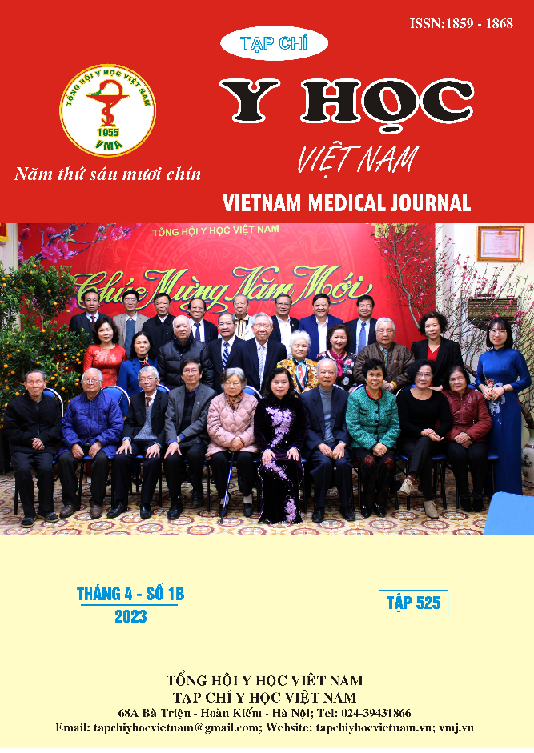ANTIBIOTIC SUSCEPTIBILITY PATTERN OF STAPHYLOCOCCUS SPECIES AT NGUYEN TRI PHUONG HOSPITAL: A 3-YEAR RETROSPECTIVE ANALYSIS
Main Article Content
Abstract
Introduction: With the high level of antimicrobial resistance worldwide, the choice of antibiotic therapy to treat infections caused by Staphylococcus species has become a major challenge in clinical practice. Objective: Determine the positive culture rate of Staphylococcus species from 2019 to 2021; Describe the prevalence and the susceptibility pattern of Staphylococcus species to several antibiotics from 2019 to 2021. Subjects and methods: Data on antibiotic susceptibility of Staphylococcus species were collected retrospectively from the Hospital Laboratory between 2019 and 2021. Chi-square test was used to performing yearly comparisons of the susceptibility. Results: Over a 3-year period, 3103 Staphylococcus strains were isolated from different samples such as pus/secretion/catheter (47.1%), blood (30.0%), respiratory tract (15.4%), urine (4.5%). Staphylococcus aureus was the major species (55.1%). After 3 years, Staphylococcus spp. were still completely sensitive to vancomycin and linezolid; sensitive more than 50% to chloramphenicol (80.4%), doxycycline (93.9%), rifampicin (93.7%) and co-trimoxazole (68.0%). MRSA rate was very high (72.4%), in which, the proportion of hVISA (MIC vancomycin 1-2 µg/mL) was 14.9%. An increase in antibiotic susceptibility of Staphylococcus spp. were observed statistically significant (p < 0.05). The antibiotic susceptibility pattern of Staphylococcus spp. in clinical departments were similar to the hospital pattern, except for the Intensive Care Unit, which had a significantly lower susceptibility rate than other departments for most tested antibiotics. Conclusions: Staphylococcus spp. were sensitive to only few antibiotics. A high proportion of MRSA and hVISA shows difficulties in treating infectious diseases, especially in the Intensive Care Unit.
Article Details
Keywords
Staphylococcus spp., antibiotic, susceptibility, resistance
References
2. Lê Huy Thạch, Lê Văn Thanh, Đỗ Thùy Dung, Ngô Văn Thắng (2021), "Đặc điểm đề kháng kháng sinh của các vi khuẩn gây bệnh thường gặp tại Bệnh viện Đa khoa tỉnh Ninh Thuận năm 2020", Tạp chí Y học Thành phố Hồ Chí Minh. 25, tr. 8.
3. Nguyễn Thị Bích Nguyên, Hoàng Tiến Mỹ (2015), "Khảo sát tình hình kháng thuốc kháng sinh của Staphylococci tại Bệnh viện Đại học Y Dược TP. Hồ Chí Minh", Tạp chí Y học Thành phố Hồ Chí Minh. 19.
4. Phạm Thái Bình, Phạm Hùng Vân, Trương Quang Vinh, Nguyễn Thị Thanh Trúc, Trần Bích Ngọc, Nguyễn Thị Trúc Anh, (2013), "Đánh giá mức độ nhạy cảm vancomycin của Staphylococcus aureus", Tạp chí Y học Thành phố Hồ Chí Minh. 17, tr. 6.
5. Trần Thị Thủy Trinh, Nguyễn Thanh Bảo (2014), "Tình hình đề kháng kháng sinh của vi khuẩn gây bệnh được phân lập tại Bệnh viện An Bình từ 1/10/2012 đến 31/5/2013", Tạp chí Y học Thành phố Hồ Chí Minh. 18, tr. 296-303.
6. O'Neill J. (2016), Tackling drug-resistant infections globally: final report and recommendations, Government of the United Kingdom.
7. Vincent J. L. et al. (2009), "International study of the prevalence and outcomes of infection in intensive care units", Jama. 302(21), tr. 2323-9.
8. Walraven C. J. et al. (2011), "Site of infection rather than vancomycin MIC predicts vancomycin treatment failure in methicillin-resistant Staphylococcus aureus bacteraemia", J Antimicrob Chemother. 66(10), tr. 2386-92.
9. Zheng X. Y. et al. (2021), "Antibiotic Resistance Pattern of Staphylococcus Aureus Isolated From Pediatrics With Ocular Infections: A 6-Year Hospital-Based Study in China", Front Pediatr. 9, tr. 728634.


